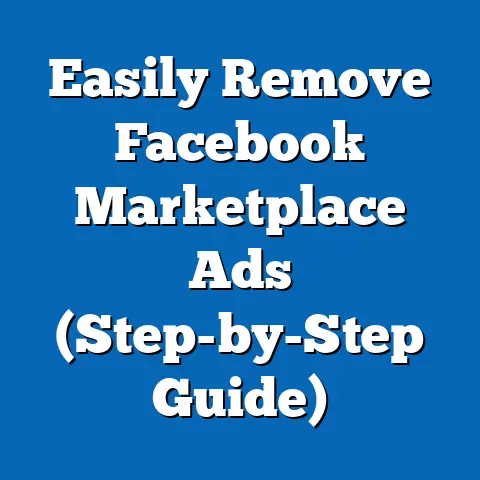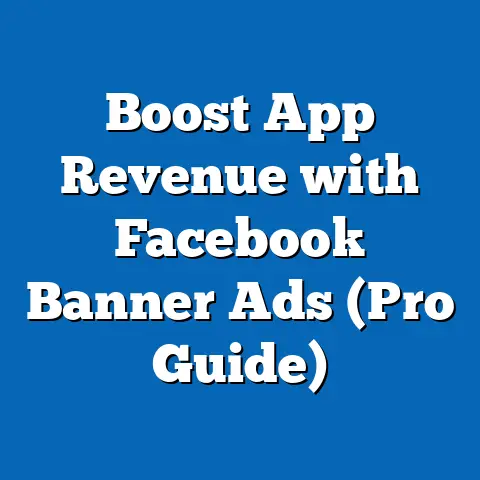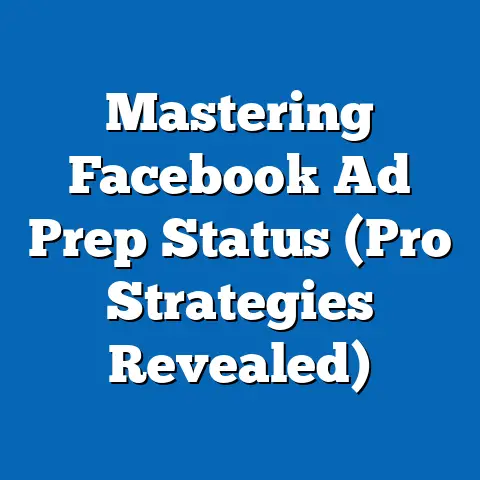Mastering Facebook Approval for Political Ads (Strategic Tips)
In today’s increasingly digital world, smart living means staying informed and making well-reasoned decisions. Political ads on platforms like Facebook play a significant role in shaping our understanding of issues and influencing our choices. It’s crucial to understand not only how to navigate this landscape but also how to ethically and effectively participate in it. Mastering Facebook’s approval process for political ads isn’t just about ticking boxes; it’s about strategically crafting messages that resonate, inform, and ultimately contribute to a more engaged and informed citizenry. This guide will delve into the intricacies of Facebook’s policies, providing actionable tips to ensure your political ads are approved, seen, and impactful. We’ll explore the verification process, compliance strategies, audience targeting, and best practices for ad performance, all while keeping transparency and ethical considerations at the forefront.
Understanding Facebook’s Ad Policies
Facebook’s ad policies are the foundation upon which all advertising activity, including political advertising, is built. These policies are in place to foster a safe, transparent, and trustworthy environment for its billions of users. Without these guidelines, the platform could easily become a breeding ground for misinformation, manipulation, and potentially harmful content.
The policies themselves are quite extensive and cover a wide range of topics, from prohibited content (hate speech, violence, etc.) to guidelines on data privacy and responsible advertising practices. For political ads, the requirements are even more stringent.
Political Ads vs. Regular Ads:
The key difference between a regular ad and a political ad on Facebook lies in the content and the intent. A political ad, as defined by Facebook, is any advertisement that:
- Refers to a candidate, election, or political figure.
- Advocates for or against a political issue of national importance.
- Is made by, on behalf of, or about a political party or group.
Because of the potential for political ads to influence public opinion and elections, Facebook requires advertisers to undergo a verification process. This process involves proving your identity and location, ensuring transparency and accountability.
Common Reasons for Ad Disapproval:
From my experience, I’ve seen many well-intentioned political ads get rejected due to seemingly minor infractions. Here are some of the most common reasons for ad disapproval:
- Misleading Information: Any ad that contains false, inaccurate, or misleading information is likely to be rejected. This includes claims about candidates, policies, or election procedures.
- Lack of Transparency: Failing to clearly identify who is paying for the ad is a major red flag. Facebook requires political ads to display a “Paid for by” disclaimer.
- Violation of Local Election Laws: Advertising must comply with all applicable election laws in the regions where the ad is being shown. This can include restrictions on timing, content, and disclosure requirements.
- Hate Speech and Discrimination: Any ad that promotes hatred, discrimination, or violence against any individual or group will be immediately rejected.
- Circumventing Systems: Trying to bypass Facebook’s review process or conceal the true nature of the ad is a surefire way to get your account flagged.
Takeaway: Familiarize yourself thoroughly with Facebook’s advertising policies, particularly those related to political ads. Understanding these policies is the first and most crucial step in ensuring your ads are approved and reach their intended audience.
The Verification Process
The Facebook verification process for political advertisers is designed to ensure transparency and accountability. It’s a multi-step process that requires advertisers to prove their identity and location. I’ve been through this process myself, and while it can be a bit tedious, it’s ultimately a worthwhile step in maintaining trust and credibility.
Steps Involved:
- Two-Factor Authentication: The first step is to enable two-factor authentication on your Facebook account. This adds an extra layer of security and helps prevent unauthorized access.
- Identity Confirmation: You’ll need to submit a copy of your government-issued photo ID, such as a driver’s license or passport. Facebook uses this to verify your identity and ensure you are who you claim to be.
- Location Confirmation: You’ll also need to provide proof of your physical address, such as a utility bill or bank statement. This helps Facebook ensure that you are advertising from the location you claim to be in.
- Disclaimer Setup: You’ll need to create a disclaimer that clearly states who is paying for the ad. This disclaimer will be displayed on all of your political ads.
- Ad Account Authorization: Finally, you’ll need to authorize your ad account to run political ads. This step confirms that you have completed the verification process and are aware of the policies and requirements for political advertising.
Required Documentation:
- Government-Issued Photo ID: This could be a driver’s license, passport, or other official identification document.
- Proof of Residence: This could be a utility bill, bank statement, or other document that shows your name and address.
- Disclaimer Information: You’ll need to provide the name and address of the individual or organization paying for the ad.
Importance of Verification:
Verifying your identity as a political advertiser on Facebook is crucial for several reasons:
- Increased Credibility: Verified advertisers are seen as more trustworthy and credible. This can help improve the performance of your ads and increase engagement.
- Compliance with Facebook Policies: Verification is a requirement for running political ads on Facebook. Failing to verify your identity can result in your ads being rejected or your account being suspended.
- Transparency and Accountability: Verification helps ensure transparency and accountability in political advertising. It allows users to see who is paying for the ads they are seeing and helps prevent the spread of misinformation.
Takeaway: The verification process might seem daunting, but it’s a necessary step for anyone who wants to run political ads on Facebook. Gather the required documentation, follow the steps carefully, and don’t hesitate to reach out to Facebook support if you have any questions.
Crafting Compliant Political Ads
Creating political ads that resonate with your audience while adhering to Facebook’s strict guidelines requires a delicate balance. It’s not enough to simply avoid explicitly prohibited content; you need to be mindful of the nuances of language, imagery, and overall messaging.
Strategic Tips:
- Clarity is Key: Ensure your message is clear, concise, and easy to understand. Avoid jargon, technical terms, or overly complex language.
- Fact-Check Everything: Before publishing any ad, double-check all facts and figures to ensure accuracy. Cite credible sources whenever possible.
- Transparency is Paramount: Clearly identify who is paying for the ad. The “Paid for by” disclaimer should be prominent and easy to read.
- Avoid Misleading Claims: Do not make any claims that are false, misleading, or unsubstantiated. This includes claims about candidates, policies, or election procedures.
- Be Respectful: Even when disagreeing with opposing viewpoints, maintain a respectful and civil tone. Avoid personal attacks, insults, or inflammatory language.
Compliant vs. Non-Compliant Language Examples:
Let’s look at some examples to illustrate the difference between compliant and non-compliant language:
| Topic | Compliant Language | Non-Compliant Language |
|---|---|---|
| Candidate Support | “Support [Candidate Name] for their commitment to improving education in our community.” | “Vote for [Candidate Name] or our schools will be ruined!” |
| Policy Advocacy | “Learn more about [Policy Name] and its potential impact on local businesses.” | “[Policy Name] is a disaster and will destroy our economy!” |
| Election Integrity | “Ensure your voice is heard by registering to vote and participating in the upcoming election.” | “The election is rigged! Don’t bother voting, it won’t make a difference.” |
| Opponent Criticism | “While we respect [Opponent Name]’s service, we believe our approach to healthcare will better serve the needs of our community.” | “[Opponent Name] is a liar and doesn’t care about your health!” |
| Topic | Compliant Language | Non-Compliant Language |
|---|---|---|
| Candidate Support | “Support [Candidate Name] for their commitment to improving education in our community.” | “Vote for [Candidate Name] or our schools will be ruined!” |
| Policy Advocacy | “Learn more about [Policy Name] and its potential impact on local businesses.” | “[Policy Name] is a disaster and will destroy our economy!” |
| Election Integrity | “Ensure your voice is heard by registering to vote and participating in the upcoming election.” | “The election is rigged! Don’t bother voting, it won’t make a difference.” |
| Opponent Criticism | “While we respect [Opponent Name]’s service, we believe our approach to healthcare will better serve the needs of our community.” | “[Opponent Name] is a liar and doesn’t care about your health!” |
Responsible Use of Images and Videos:
Images and videos can be powerful tools for conveying your message, but they must be used responsibly. Here are some considerations:
- Copyright: Ensure you have the rights to use any images or videos in your ads. Using copyrighted material without permission can lead to legal trouble and ad disapproval.
- Representation: Be mindful of how people are represented in your ads. Avoid using images or videos that are offensive, discriminatory, or exploitative.
- Authenticity: Do not use manipulated or altered images or videos to deceive or mislead viewers.
- Relevance: Ensure that the images and videos you use are relevant to the message you are trying to convey.
Takeaway: Crafting compliant political ads requires careful attention to detail and a commitment to transparency, accuracy, and respect. By following these guidelines, you can increase your chances of getting your ads approved and reaching your target audience.
Targeting Your Audience Effectively
Even the most well-crafted and compliant political ad will fall flat if it doesn’t reach the right audience. Facebook offers a robust suite of targeting tools that allow you to tailor your ads to specific demographics, interests, and behaviors. Understanding how to use these tools effectively is crucial for maximizing the impact of your political advertising efforts.
Facebook’s Audience Targeting Tools:
- Demographics: Target users based on age, gender, location, education, relationship status, and other demographic factors.
- Interests: Target users based on their interests, hobbies, and activities. Facebook gathers this information from users’ profiles, pages they like, and content they engage with.
- Behaviors: Target users based on their online behavior, such as purchase history, device usage, and travel patterns.
- Custom Audiences: Create custom audiences based on your own data, such as email lists, website visitors, or app users.
- Lookalike Audiences: Create lookalike audiences based on your existing custom audiences. Facebook will find users who are similar to your best customers or supporters.
Understanding Your Audience:
Before you start targeting your ads, it’s essential to understand your audience. Who are you trying to reach? What are their values, beliefs, and concerns? What motivates them?
To answer these questions, you need to conduct thorough audience research. This can involve:
- Analyzing Existing Data: Look at your website analytics, social media data, and customer surveys to gain insights into your current audience.
- Conducting Surveys and Polls: Ask your audience directly about their opinions, preferences, and concerns.
- Creating Audience Personas: Develop detailed profiles of your ideal audience members. These personas should include information about their demographics, interests, behaviors, and motivations.
Data Analytics and Refinement:
Audience targeting is not a one-time effort. You need to continuously monitor the performance of your ads and refine your targeting strategies based on the data you collect.
Facebook Ads Manager provides a wealth of data on your ad performance, including:
- Reach: The number of people who saw your ad.
- Impressions: The number of times your ad was displayed.
- Engagement: The number of likes, comments, shares, and clicks your ad received.
- Conversions: The number of people who took a desired action, such as visiting your website, signing up for your email list, or donating to your campaign.
By analyzing this data, you can identify which targeting strategies are working and which are not. You can then adjust your targeting accordingly to improve your ad performance.
Takeaway: Effective audience targeting is crucial for maximizing the impact of your political advertising efforts. By understanding your audience and using Facebook’s targeting tools strategically, you can ensure that your ads reach the people who are most likely to be interested in your message.
Best Practices for Ad Performance
Getting your political ads approved is only half the battle. Once your ads are live, you need to continuously monitor their performance and make adjustments to optimize their effectiveness. This involves A/B testing, monitoring key metrics, and adapting your campaigns in real-time.
A/B Testing Strategies:
A/B testing, also known as split testing, is a powerful technique for comparing different versions of your ads to see which performs best. This can involve testing different:
- Headlines: Try different headlines to see which ones attract the most attention.
- Body Copy: Experiment with different messaging to see which resonates best with your audience.
- Images and Videos: Test different visuals to see which ones are most engaging.
- Call-to-Actions: Try different calls-to-action to see which ones drive the most conversions.
- Targeting Options: Test different targeting options to see which audiences are most responsive.
Monitoring Ad Metrics:
Key metrics to monitor include:
- Reach: As mentioned earlier, this tells you how many people saw your ad.
- Impressions: How many times your ad was displayed.
- Click-Through Rate (CTR): The percentage of people who saw your ad and clicked on it. A higher CTR indicates that your ad is relevant and engaging.
- Cost Per Click (CPC): The amount you pay each time someone clicks on your ad. A lower CPC indicates that your ad is efficient.
- Conversion Rate: The percentage of people who clicked on your ad and took a desired action. A higher conversion rate indicates that your ad is effective.
- Return on Ad Spend (ROAS): This measures the revenue generated for every dollar spent on advertising. A higher ROAS indicates that your ad campaign is profitable.
Adjusting Campaigns in Real-Time:
The beauty of Facebook advertising is that you can adjust your campaigns in real-time based on performance data. If you see that an ad is not performing well, you can pause it, edit it, or try a different targeting strategy.
For example, if you notice that your CTR is low, you might try changing your headline or image. If you see that your CPC is high, you might try refining your targeting options.
Feedback Loops:
The insights you gain from your current campaigns should inform your future ad strategies. This is what I call a feedback loop. By continuously analyzing your data and learning from your successes and failures, you can improve your ad performance over time.
Takeaway: Optimizing ad performance is an ongoing process that requires continuous monitoring, testing, and refinement. By using A/B testing, monitoring key metrics, and adjusting your campaigns in real-time, you can maximize the effectiveness of your political advertising efforts.
Conclusion
Mastering Facebook’s approval process for political ads is more than just a technical exercise; it’s a strategic imperative for anyone seeking to participate effectively in the digital public square. By understanding Facebook’s policies, navigating the verification process, crafting compliant ads, targeting your audience effectively, and optimizing your ad performance, you can ensure that your message is heard and that your voice contributes to a more informed and engaged citizenry.
Political advertising, when executed ethically and strategically, has the potential to drive positive change. It can inform voters, mobilize support for important causes, and hold elected officials accountable. However, it’s crucial to remember that with great power comes great responsibility. As political advertisers, we have a duty to be transparent, accurate, and respectful in our messaging.
I encourage you to view political advertising not just as a means to an end, but as a way to foster informed citizenry and active engagement in the democratic process. By embracing ethical principles and strategic best practices, we can harness the power of Facebook to create a more informed, engaged, and just society.
Call to Action: Share your experiences with Facebook political ads in the comments below. What challenges have you faced? What strategies have worked well for you? And be sure to stay informed about ongoing changes in social media advertising policies. The digital landscape is constantly evolving, and it’s crucial to stay ahead of the curve.






